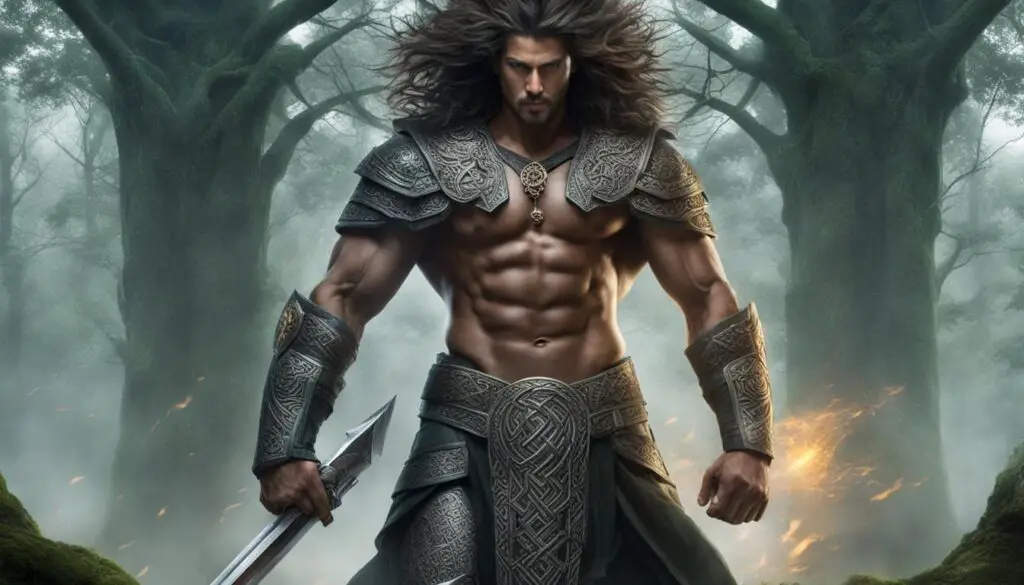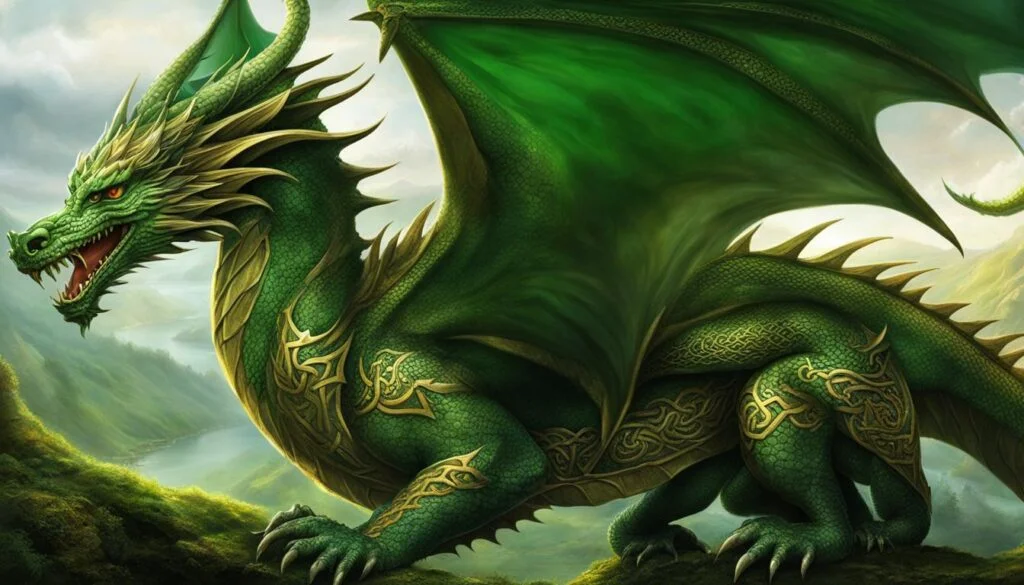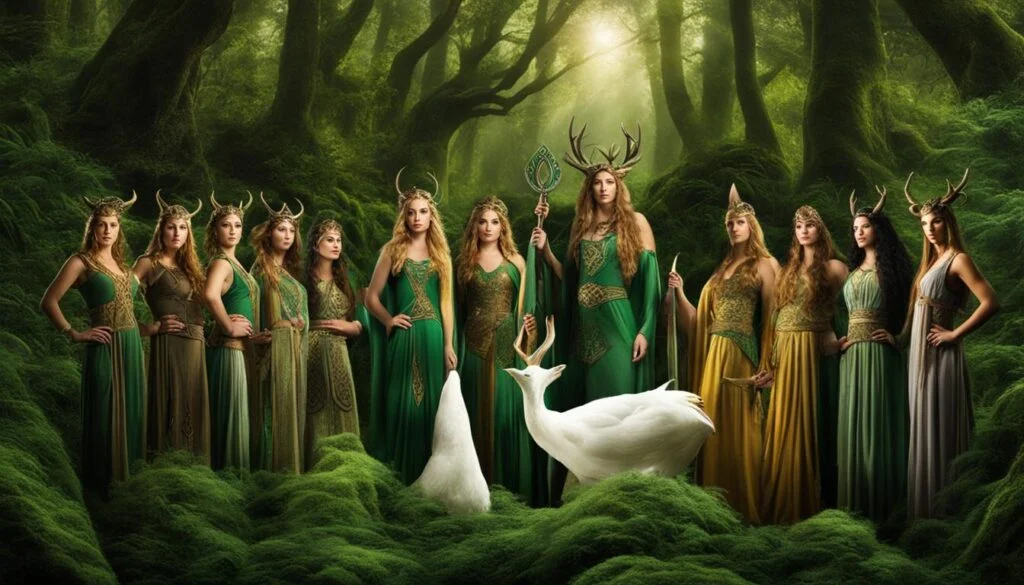Step into the world of Celtic mythology and explore the ancient gods that once ruled the Celtic pantheon. Delve into the rich tapestry of mythology and folklore that has captivated generations. Discover the most powerful Celtic god and unlock the secrets of ancient Celtic deities. Join us on a journey through time and immerse yourself in the enchanting realm of Celtic gods and goddesses.
Key Takeaways:
- The Dagda, also known as “The Good God,” is considered the most powerful Celtic god.
- The Dagda is associated with wisdom, strength, and abundance.
- Danu, The Morrigan, Aengus, and Balor are also among the most powerful Celtic gods and goddesses.
- Celtic mythology offers a glimpse into the ancient lore and enigma of Celtic culture.
- Explore the fascinating Celtic pantheon and uncover the ancient mythology that continues to inspire us today.
The Dagda – Leader of the Celtic Pantheon
In Celtic mythology, The Dagda holds the esteemed position of being the leader of the Celtic pantheon. Revered for his wisdom, strength, and abundance, The Dagda is considered the most powerful god in Celtic mythology. Often likened to the formidable deities Odin and Zeus, The Dagda commands respect and admiration from both mortals and fellow gods alike.
As the father of numerous Irish Celt gods, The Dagda plays a pivotal role in the intricate tapestry of Celtic mythology. His divine lineage and exceptional abilities place him in a league shared only by the most revered supernatural beings. Belonging to the enigmatic race known as the Tuatha dé Danann, The Dagda embodies the essence of Celtic power and mystique.
Danu – The Matriarch of Power
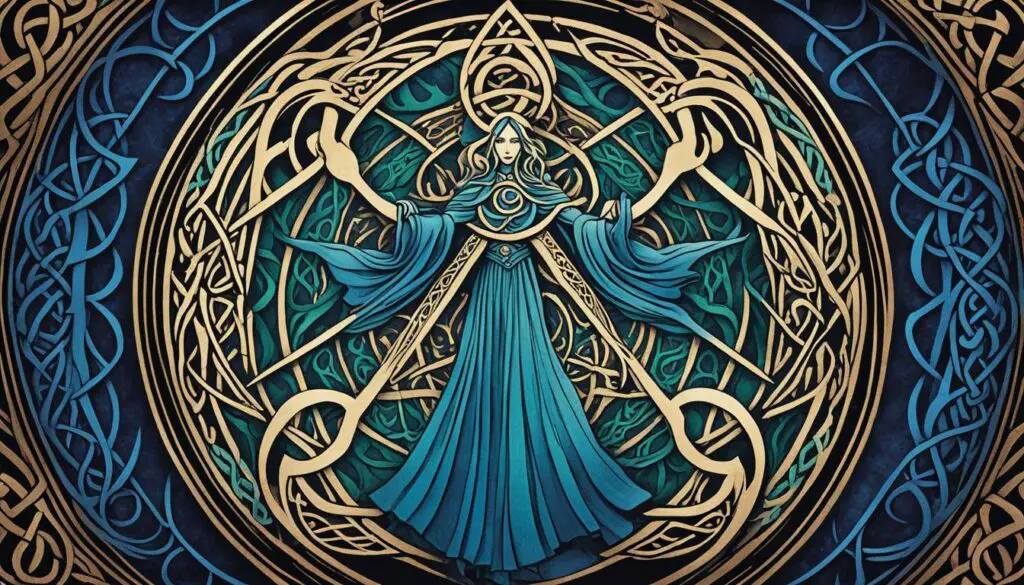
In Celtic mythology, Danu is revered as the matriarch of power within the Celtic pantheon. She is deeply intertwined with nature and is believed to hold the ancestral essence of the gods. Often depicted as a mortal woman, Danu’s influence can be seen through various symbolic representations, including fish, seagulls, horses, and the triple goddess symbol.
As a central figure in Celtic mythology, Danu plays a significant role in the creation myth, where she embodies the divine feminine energy and holds immense power over the natural world. Her association with the triple goddess symbol further emphasizes her role as a mighty force in Celtic lore, representing the three stages of a woman’s life and the interconnectedness of maidenhood, motherhood, and cronehood.
Through her representation as the matriarch of power, Danu embodies the strength and wisdom inherent in the Celtic mythological tradition. Her presence serves as a reminder of the profound influence that women held in ancient Celtic society, both as divine beings and as sources of power and guidance.
The Morrigan – Celtic Version of the Valkyrie
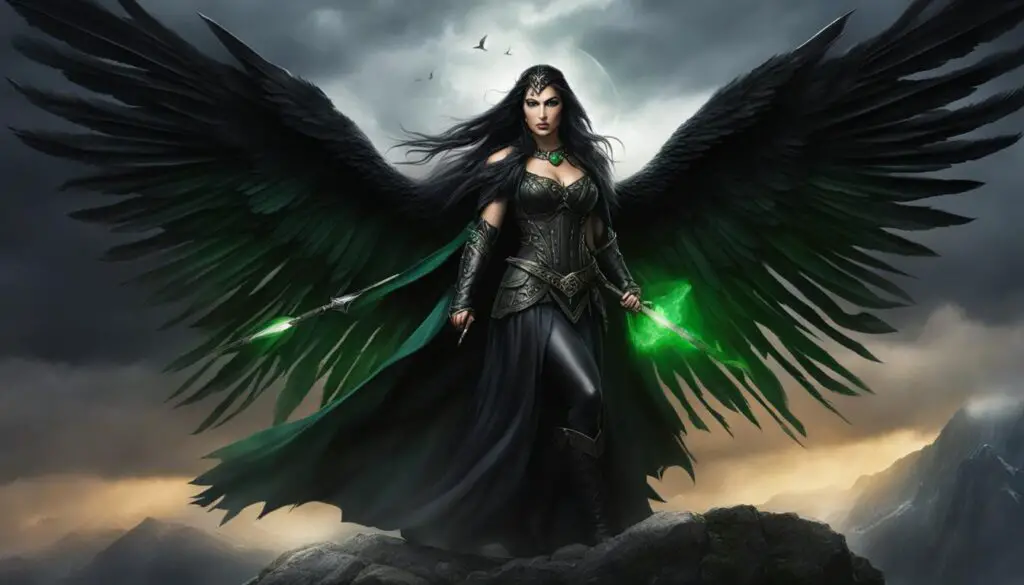
In Celtic mythology, The Morrigan is a powerful goddess associated with war and fate. Similar to the Nordic Valkyrie, she possesses a fierce and prophetic nature. The Morrigan often takes the form of a crow named Badb, a creature symbolizing both death and transformation.
As the wife of The Dagda, the leader of the Celtic pantheon, The Morrigan holds a significant position within the mythological hierarchy. She is commonly depicted as the phantom queen, shrouded in mystery and allure. The name “The Morrigan” translates to “the phantom queen,” further emphasizing her enigmatic nature.
Legends suggest that The Morrigan played a key role in inspiring warriors, imbuing them with bravery and heroism on the battlefield. Her presence was believed to influence the outcome of wars and determine the fate of individuals. The Morrigan’s influence extends beyond mortal affairs, as she is also associated with sovereignty and the cycle of life and death.
Symbolism and Influence
The Morrigan’s association with the crow is deeply symbolic. These black birds often invoke a sense of mystery and darkness, highlighting her connection to the supernatural and the otherworldly. Additionally, crows are known for their intelligence and keen observation skills, aligning with The Morrigan’s role as a seer and prophetess.
The Morrigan’s influence extends beyond Celtic mythology and has permeated into other cultural narratives. In Arthurian legends, she is believed to be the inspiration for the character Morgana, the cunning and malevolent sorceress. This demonstrates The Morrigan’s enduring presence and impact on storytelling and folklore.
The image above captures the essence of The Morrigan, showcasing both her Celtic roots and her connection to the Valkyrie. It portrays her in the form of a crow, emphasizing her role as a shape-shifter and harbinger of death and transformation.
Stay tuned for the next section, where we discover another fascinating deity in Celtic mythology!
Aengus – The God of Love
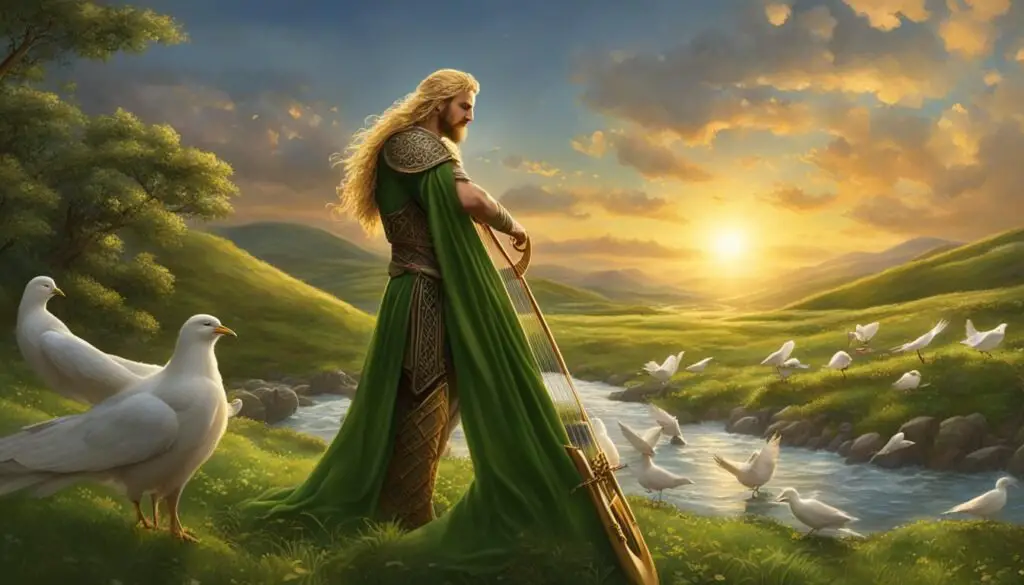
In Celtic mythology, Aengus is revered as the god of love. He is the son of the powerful Celtic deity, The Dagda. Aengus is known for his captivating love story with Caer Ibormeith, a woman who transforms into a swan.
This enchanting tale has drawn comparisons between Aengus and the Greek god Hermes or Cupid, both associated with love and passion. Aengus embodies the essence of romance and desire, captivating the hearts of mortals and immortals alike.
Aside from his role as the god of love, Aengus is also known for his mythical artifacts and symbols. He possesses objects of great significance that hold immense power within Celtic mythology. These artifacts symbolize his influence and mastery over love and desire.
Furthermore, Aengus is often depicted riding a magnificent white horse, which represents purity and grace. This majestic creature adds to his allure and emphasizes his divine nature.
Explore the wondrous realm of Celtic mythology and unlock the mysteries surrounding Aengus, the god of love, as he guides us through the realms of passion, enchantment, and timeless romance.
Balor – The God of Chaos
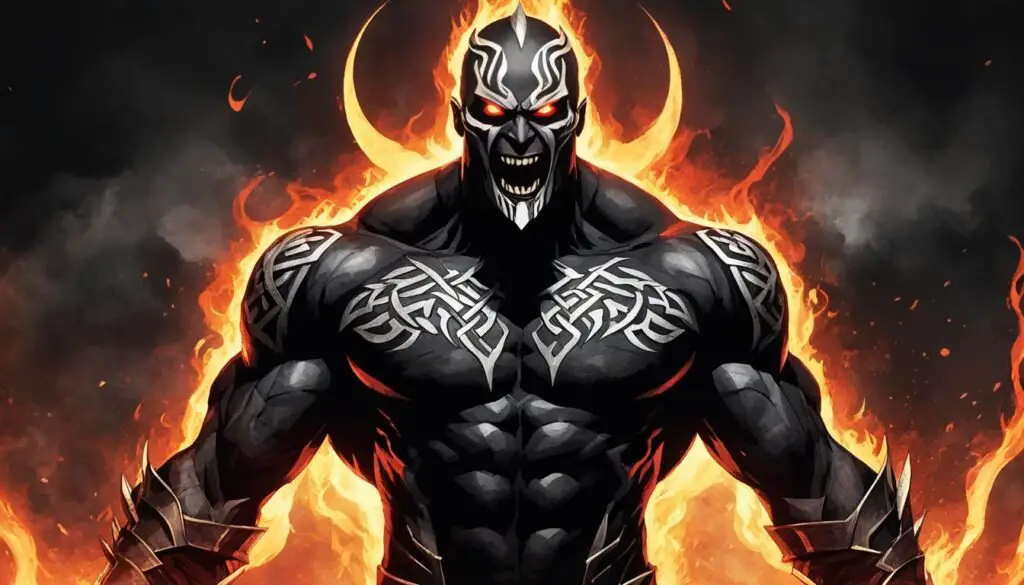
In Celtic mythology, Balor is an influential deity known as the god of chaos. He holds the position of the leader among the Formorians, a fearsome race that posed a threat to the Irish Celtic people. Depicted as a towering figure, Balor is often represented with one or three eyes, which possess the power to bring about destruction and mayhem.
This Celtic god’s story draws parallels to the Greek Cyclops, known for their single eye, and the ominous power it possesses. The evil eye of Balor symbolizes his destructive abilities and exemplifies his role as the god of chaos in Celtic mythology.
Discover more about the captivating gods and goddesses of Celtic mythology in our other sections.
Cliodhna – The Goddess of Beauty
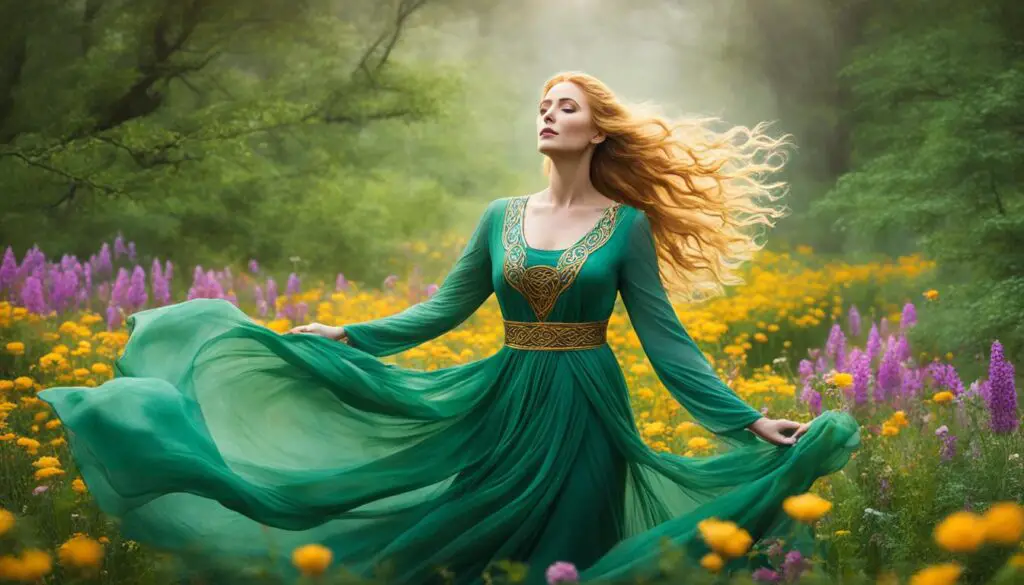
In Celtic mythology, Cliodhna is revered as the goddess of beauty. She is known for her ethereal charm and radiant aura that captivates all who behold her. Cliodhna is often depicted surrounded by brightly colored birds, symbolizing her connection to nature and her ability to bring beauty and joy to the world.
This Celtic goddess also holds the power of healing, and it is believed that she has the ability to bring rain and fertility to the land. Through her divine influence, Cliodhna brings forth abundance and renewal, nurturing the harmony between humanity and the natural world.
One of the most fascinating legends associated with Cliodhna is the tale of the Blarney Stone in Ireland. It is said that the ruler of Blarney Castle, in a desperate plea to gain eloquence and charm, prayed to Cliodhna. In response to his prayers, the goddess kissed the stone, imbuing it with her enchanting powers. Ever since, those who kiss the Blarney Stone are said to be granted the gift of eloquence.
In Celtic culture, the three birds are a significant symbol associated with Cliodhna. Representing her divine presence and influence, these birds are often depicted in Celtic artwork and serve as a reminder of the goddess’s beauty and grace.
As the goddess of beauty, Cliodhna reminds us of the inherent splendor found within the world and encourages us to find and appreciate beauty in our daily lives. Her presence is a testament to the profound connection between nature, spirituality, and the human spirit.
Lugh – The Mythological Warrior God
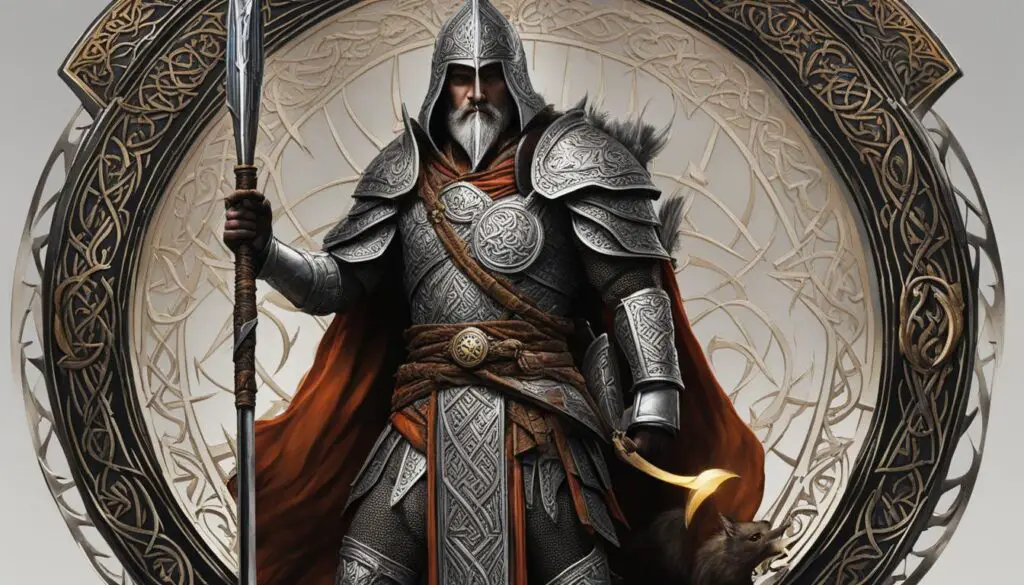
In Celtic mythology, Lugh is revered as a powerful warrior god with a prominent role in Irish folklore. He is often depicted as a skilled combatant, carrying a flaming spear and riding a majestic white horse. Lugh’s physical prowess and leadership qualities have earned him a reputation as a formidable and revered figure.
What sets Lugh apart from the other Celtic gods is his association with sports and athletic prowess. He is believed to be the creator of several sporting events in Celtic culture, showcasing his multifaceted nature as both a warrior and a patron of athletic competition.
Similar to the Norse god Thor, Lugh is known for his association with storms and is often depicted as a guardian of the skies, wielding his powerful spear with thunderous force. This resemblance to Thor highlights the shared attributes of these mythological warrior gods from different cultures.
Overall, Lugh’s depiction as a mythological warrior god and creator of sports in Celtic mythology showcases his diverse and complex nature. His physical strength, leadership abilities, and association with both athletic prowess and storms make him a revered figure in Celtic folklore.
Key Points:
- Lugh is an Irish mythological warrior god in Celtic mythology.
- He is often depicted with a flaming spear and a white horse.
- Lugh is known for his physical prowess and leadership qualities.
- He is believed to be the creator of several sporting events in Celtic culture.
- Lugh shares similarities with the Norse god Thor, both being powerful warriors associated with storms.
Conclusion
Celtic mythology is a fascinating world of gods and goddesses, steeped in ancient lore that has intrigued people for centuries. At the heart of this enigma of Celtic mythology is The Dagda, the most powerful god and the leader of the Celtic pantheon. He stands tall among other revered deities such as Danu, The Morrigan, Aengus, and Balor, each wielding their unique powers and playing significant roles in the rich tapestry of Celtic mythology.
The stories of these gods and goddesses offer us a glimpse into the beliefs and traditions of the ancient Celts, showcasing their deep connection with the natural world and their reverence for the divine. From Danu, the matriarch of power, to The Morrigan, the Celtic Valkyrie, and Aengus, the god of love, each deity brings their own essence to the vast and intricate world of Celtic mythology.
This ancient lore continues to inspire and intrigue us, captivating our imaginations with its mystical tales. The pantheon of Celtic gods and goddesses remains a source of fascination, reminding us of our collective human fascination with the divine and our quest for understanding the mysteries of the world around us. Celtic mythology is an eternal wellspring of wisdom and magic, an enduring testament to the richness of human imagination and the enduring enigma of Celtic mythology.
FAQ
Who is the most powerful Celtic god?
The most powerful Celtic god is The Dagda, also known as “The Good God.”
Who is the leader of the Celtic pantheon?
The leader of the Celtic pantheon is The Dagda.
What are the characteristics associated with The Dagda?
The Dagda is associated with wisdom, strength, and abundance.
Who is Danu in Celtic mythology?
Danu is the matriarch of power in the Celtic pantheon and is associated with nature.
What symbols are associated with Danu?
Danu is associated with symbols such as fish, seagulls, horses, and the triple goddess symbol.
Who is The Morrigan in Celtic mythology?
The Morrigan is the Celtic version of the Nordic Valkyrie and is often associated with war and fate.
What is The Morrigan’s role in Celtic mythology?
The Morrigan inspires warriors to be heroic and brave and is often depicted as the phantom queen.
Who is Aengus in Celtic mythology?
Aengus is the god of love and the son of The Dagda.
What is Aengus associated with?
Aengus is associated with love, passion, mythical artifacts, and riding a white horse.
Who is Balor in Celtic mythology?
Balor is the god of chaos and the leader of the Formorians, a demonic race that threatened the Irish Celtic people.
What is characteristic of Balor?
Balor is often depicted as a giant with one or three eyes, which have the power to cause destruction.
Who is Cliodhna in Celtic mythology?
Cliodhna is the goddess of beauty who is associated with healing and the power to bring rain and fertility.
What symbol is associated with Cliodhna?
Cliodhna is associated with brightly colored birds, and her symbol in Celtic culture is the three birds.
Who is Lugh in Celtic mythology?
Lugh is an Irish mythological warrior god who is known for his physical prowess and leadership.
What are Lugh’s notable attributes?
Lugh is often depicted with a flaming spear and a white horse and is considered the creator of several sporting events in Celtic culture.
What is Celtic mythology?
Celtic mythology is a rich and complex tapestry of gods and goddesses that have captivated people for centuries, offering a glimpse into the beliefs and traditions of the ancient Celts.


